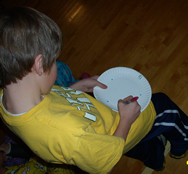3D Model to Visit School
Students built a model of the results of the Let There Be Night experiment using over 35,000 LEGO blocks to represent the ideal night sky. From that 3D map, over 12,000 blocks had to be removed to represent the night sky lost to light pollution, according to over 3,400 student observations. The 3D model will be displayed at Meadows Edge on January 19-22, 2010.
 School Sleepover Features a Night of Stars
School Sleepover Features a Night of Stars
The stars came out at the Meadow's Edge Sleepover on March 27, 2009, as students interacted with teacher Jenny McCarthy
and planetarium director Art Klinger
under an inflatable dome.With storytelling under the stars, Orion the Hunter segued from a legend of days past to the modern target of observations for the community light pollution experiment.
With an exposed light, Mr. Klinger was able to show the three main aspects of light pollution--glare, light trespass, and sky glow.
Yet when he shielded the light, the shoes below and the stars above alike came into view.Even the adult volunteers came in to see what the buzz was all about.
Later, the Student Leadership Team (SLT) recorded its nightly SQM readings in the back playground. A telescope revealed the thin rings of Saturn, but a cold breeze shortened the time outdoors.
 Student Artwork Features Orion
Student Artwork Features Orion
Students at Meadow's Edge Elementary School depict Orion in art.
A poster at Meadow's Edge appeals for LEGO blocks to support LTBN. Meanwhile, every night a team of students is measuring sky glow with a hand-held Sky Quality Meter (SQM).
Images courtesy of Lauren Parker.

 School News
School News
Meadows Edge student Kennedy P. announces the Let There Be Night program on the school news, left. Later, she represented the school at a student meeting with Mishawaka Mayor Jeff Rea to discuss Let There Be Night, outdoor lighting issues, and Earth Hour, occurring March 28th. See the related WNDU TV story.
Turtle Hatch Activity
Students as sea turtle hatchlings scurry from predators during the Turtle Hatch activity at the 2009In Your Dreams Book Night at Meadows Edge Elementary School. Members of the Student Leadership Team record the positions of the hatchlings ater two "hatches"--one in the prescence of light pollution, and a second time after the students addressed outdoor lighting issues and adjusted some of the "shoreside" fixtures.





Images above courtesy of Laban Kauffman.
Prior to hatching, turtles (rather, students) get instructions from Mr. Bueter. Image above courtesy of Lauren Parker.
 The LTBN Student Leadership Team at Madison recorded on paper plates the results of two trial runs to show the change in turtle survival rates when outdoor lighting was altered.
The LTBN Student Leadership Team at Madison recorded on paper plates the results of two trial runs to show the change in turtle survival rates when outdoor lighting was altered.
Image, right,courtesy of John Mott.
The evening included a reading of There Once Was a Sky Full of Stars, and some raffle prizes that included the Let There Be Night DVD set and the NASA WISE Mission's lenticular postcards of Orion in visible and infrared light.
Constellation Book
Our class decided to create this book as an introduction of the constellations before we go on our planetarium field trip on January 30, 2009. We wanted to share what we learned with other students also. As a part of our "Let There Be Night" program, we know that light pollution is making our night sky brighter and we can't see the stars. We decided to make this book in order to know where the constellations should be and what they look like even with light pollution. Please enjoy our book!
Mrs. Stephanie Betzer's 4/5 Class
(Click images below to enlarge.)
 |
 |
 |
 |
 Teachers Prepare
Teachers Prepare
Meadows Edge teachers prepare for Let There Be Night at an in-service meeting on October 1, 2008. The support of teachers is paramount to the success of this community-wide science experiment.
